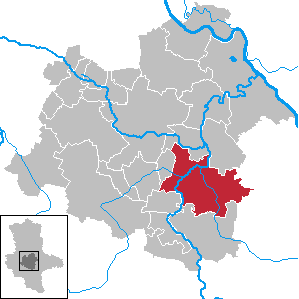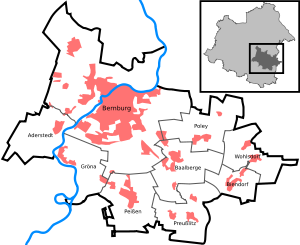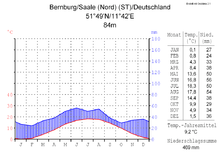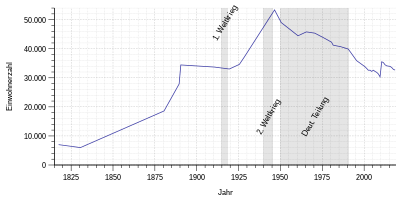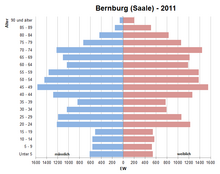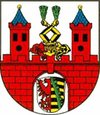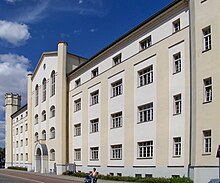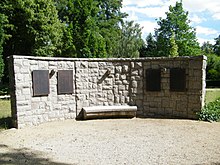Bernburg (Saale)
| coat of arms | Germany map | |
|---|---|---|
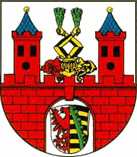
|
Coordinates: 51 ° 48 ' N , 11 ° 45' E |
|
| Basic data | ||
| State : | Saxony-Anhalt | |
| County : | Salzlandkreis | |
| Height : | 85 m above sea level NHN | |
| Area : | 113.47 km 2 | |
| Residents: | 32,573 (Dec. 31, 2019) | |
| Population density : | 287 inhabitants per km 2 | |
| Postcodes : | 06406, 06392 | |
| Area code : | 03471 | |
| License plate : | SLK, ASL, BBG, SBK, SFT | |
| Community key : | 15 0 89 030 | |
| LOCODE : | DE BEQ | |
| NUTS : | DEE0C | |
| City structure: | 8 districts | |
City administration address : |
Schlossgartenstrasse 16 06406 Bernburg (Saale) |
|
| Website : | ||
| Lord Mayor : | Henry Schütze (independent) | |
| Location of the city of Bernburg (Saale) in the Salzlandkreis | ||
Bernburg (Saale) is the district town of the Salzlandkreis in the center of Saxony-Anhalt . Bernburg is located on the Saale about 40 kilometers south of Magdeburg and 35 kilometers north of Halle (Saale) . Bernburg is historically a part of Anhalt and was the residential city of the Anhalt-Bernburg branch line .
geography
Geographical location
Bernburg is located on the Saale south of Magdeburg and north of Halle. Its location south of the glacier advances of the last Ice Age (around 12,000 years ago) in the middle of the black earth area of the Magdeburg Börde offers good agricultural conditions. In the glacier garden on the outskirts there are still slabs of stone with ice age scratches.
City structure
The city of Bernburg is made up of the mountain and valley cities (the two cities merged on March 21, 1825). The valley town of Bernburg, in turn, is divided into the old and new towns of Bernburg. There are also other residential areas, such as B .:
- Anton Saefkow settlement . The garden city between John-Schehr- and Horst-Heilmann-Straße, planned by architect Leopold Fischer , was built at the end of the 1920s. It is popularly called "zigzag house" because the fronts of the individual row houses, rotated by 90 degrees, are offset.
- Friedenshall (formerly Solvayhall )
- Harnack settlement (previously cemetery settlement)
- Schulze-Boysen -Siedlung (formerly Junkers settlement; Kopernikus-, Galilei- Bunsen- and Nernststraße) Most of the apartment buildings from the 1930s were demolished from 2010 onwards. The remainder is being renovated and modernized.
The eight districts belong to Bernburg :
| Locality | Residents | Districts |
The towns of Bernburg (Saale) (clickable map) |
|---|---|---|---|
| Aderstedt | 550 | Aderstedt | |
| Baalberg | 1,363 | Baalberge, Kleinwirschleben | |
| Biendorf | 810 | Biendorf | |
| Grona | 554 | Grona | |
| Piss | 1,202 | Piss | |
| Poley | 602 | Weddegast, Poley | |
| Preusslitz | 728 | Leau , Plömnitz , Preusslitz | |
| Wohlsdorf | 505 | Crüchern , Wohlsdorf |
The five districts are:
- Chubby
- Neuborna (start of construction: early 1933)
- Roschwitz
- Strenzfeld
- Waldau
Other places are:
- Vorwerk Gnetsch
- Vorwerk Zepzig with garbage dump Zepzig
climate
Bernburg lies in the middle of the central German dry area in the rain shadow of the Harz Mountains and is assigned to the climatic area of the eastern Harz foreland, the driest area in Germany. Based on data from the German Meteorological Service, Bernburg is in last place in a ranking of 50 German cities examined with an average annual rainfall of just 469 millimeters (rain shadow of the Harz). The location in this climatic area also means higher summer temperatures; on July 31, 2018, the highest annual temperature in Germany was measured at 39.5 ° C. The average air temperature in Bernburg is 9.2 ° C.
history
From prehistory to 1600
Bernburg is the eponymous place of discovery for evidence of settlement of the Bernburg culture , a subgroup of the Neolithic beaker culture .
The area around Bernburg is characterized by fertile loess soils and was therefore one of the preferred settlement areas in earlier times. Research results from 2010 locate the settlement Luppia , which Ptolemy had recorded in his Atlas Geographia around 150 AD , in the Bernburg area. In the early Middle Ages, the Saale separated the residential areas of the Teutons from those of the Slavs. In the area of today's city of Bernburg there was once a convenient river crossing. At that time, however, the Saale made a curve and flowed a little further west, between today's Neustadt and the Waldau district . The current district of Waldau was first mentioned in 782 and 806 as "Waladala" in the chronicle of the Moissac monastery (today in the Bibliothèque nationale de France in Paris ). On July 29, 961, a “ civitas Brandanburg” appears in a deed of gift from the later Emperor Otto I. For a long time it was questionable whether this was Bernburg. It was not until 1960 that local researcher Franz Stieler found a copy of the document from 961 in a 15th century copy, which contains the explanatory glossary "Berneburg" for "Brandanburg". The next reliable mention of a Bernburg castle took place in 1138: two chronicles - those of the Annalista Saxo and the Magdeburg Annals - reported that the enemies of Albert the Bear infected the "Berneburch" where his mother resided.
In addition to this castle, there was probably another early medieval fortification on the west bank of the Saale, which could have emerged from the former Franconian royal court "Waladala", which became the Gernroder monastery courtyard in the second half of the 10th century . In the area of the valley town, in the area of the Neustädter parish church St. Nikolai, an early urban long-distance merchant settlement can be assumed. After the influence of the Askanians on the Nienburg monastery and the important Saale crossing located there in 1166, the construction of a safe river crossing in Bernburg became more important.
Together with the reconstruction of the castle from the second half of the 12th century, the Bergstadt parish church of St. Aegidien was also rebuilt. The Aegidien patronage and the elaborate building type of this church as a Romanesque basilica with a crossing tower indicate that the construction of the Bergstädter parish church was part of a settlement project for new settlers from the western parts of the empire, who are now to intensify the Ascanian land development in the Bernburg area Castle should settle. At the same time, a Slavic Kietz settlement was built in front of the castle in the area of today's Fischergasse . The sale of agricultural products to long-distance merchants created the basis for the creation of a local market and service settlement in the area of Bernburg's old town in the Saale valley. This then developed into a Gothic market town in the first half of the 13th century through the targeted settlement of craftsmen and merchants and the involvement of merchants from the Nikolaisiedlung, which had now become a subordinate, but independent new town.
The first evidence of a mill on the Saale comes from the year 1219. The slope of the Bernburg Saale was well suited for the mill. The first Saale bridge was mentioned in 1239. It was repeatedly destroyed and renewed until the 20th century. 1278 received Old and New Town by Bernhard I of Anhalt-Bernburg the city charter . In 1293, at the instigation of the abbot of the Nienburg monastery, Slavic was banned as the court language in Anhalt-Bernburg. The Bernburg monastery (today St. Johannes-Hospital) was mentioned for the first time in 1308, the mountain town in 1326. The regional legend connects the place of the story in which Till Eulenspiegel hired himself out as a tower blower for the Count of Anhalt with the keep of Bernburg Castle . However, since there were two bergfrieds at Bernburg Castle in the 15th century and the Eulenspiegel Tower was still referred to as the “club-light thorm” in 1497, it can be assumed that this transfer only took place as a reaction to the reception of Eulenspiegelstoff at the Bernburger Fürstenhof. In 1640, the name "Eulenspiegel" for the round keep of the core castle that is preserved today is first recorded in the Bernburger Salbuch. Because of the importation of duty unpaid goods by water, the Herring War broke out in 1426 , an armed customs dispute with the Hanseatic city of Magdeburg . In 1526, the Reformation was introduced in Anhalt-Bernburg as the third state in the world, after Saxony and Anhalt-Köthen . On October 21, 1530, the Archbishopric of Magdeburg received a privilege from the Catholic Emperor Charles V for free navigation on the Saale with simultaneous permission to expand the river bed. As a first measure for this, the construction of the weir in Bernburg was started in the same year. In 1559, at the initiative of the beneficiary archbishopric, a contract was signed between Archbishop Sigismund and Prince Wolfgang von Anhalt for the purpose of expanding and securing shipping on the Saale. On this basis, the construction of the first wooden lock in Bernburg began in 1560. The area downriver from the lock to the Saale bridge has since been called Little Venice, the slope above this harbor as a beautiful angle. As early as 1605, due to the decline of shipping on the Saale at that time, taxes had to be levied for the maintenance of the locks.
In the witch hunts from 1555 to 1664 at least 46 people were accused in the city and office of Bernburg. The witch trial 1617–1619 against the wife of the mayor Meyhen, Barbara Meyhe, became known . On December 9, 2015, the unveiling of a memorial plaque for the victims of the witch hunt took place in Bernburg (Saale) at the former rectory of the St. Marien church, Altstädter Kirchhof 10.
1600 to 1900
In 1595, a flood destroyed 160 houses in the valley town. In 1603 Bernburg became the residence and garrison town of the principality (from 1807 duchy of Anhalt-Bernburg) . In the Thirty Years War Heinrich von Holk conquered and plundered the city with his "Holk'schen Reiter" in 1630 , a plague epidemic claimed 1700 victims during this time. In 1666 a fire raged in the old town. The last plague epidemic struck Bernburg in 1682. In 1697 the first stone lock on the Saale was inaugurated.
In 1745 the first steam engine for mining was constructed in Bernburg . In 1757 and again from 1807 to 1813 Bernburg was under French occupation. Valley and mountain towns were combined to form the town of Bernburg in 1825. The Anhalt-Cöthen-Bernburger Eisenbahn-Gesellschaft opened Köthen's third station in 1846 and thus Bernburg's first rail connection to the stations of the Magdeburg-Köthen-Halle-Leipzig Railway Company (1840) and the Berlin-Anhalt Railway (1841).
A bear pen was built in the castle in 1860 to hold the first brown bear arriving from Russia in 1858 . The kennel was renewed in 1996 according to animal welfare principles.
In 1863 the Duchy of Anhalt-Bernburg ended with the death of the last Duke Alexander Carl . The Solvay works were opened in 1883, and salt mining began in 1884, making Bernburg the largest town in Anhalt for a short time. In 1891 the first steel bridge was built over the Saale. In 1895 the district of Bernburg had a new hospital built in the style of a pavilion through the company Gropius & Schmieden .
1900 to the present
In 1902 the city became Solbad and got a spa house. The Kessler Tower was inaugurated in 1913 , named after its founder, Kommerzienrat Theodor Kessler (1839–1917), partner in the Bernburg pewter foundry L. Kessler & Sohn. In 1913, the Bernburger Kaliwerke (Wintershall AG) started mining. After the end of the First World War , Bernburg lost his garrison as a result of Part V of the Versailles Peace Treaty . The city of Bernburg acquired the Karlskaserne in 1919 and converted it into the town hall. From January 1, 1924, no military was stationed in Bernburg. The state police then moved into the Franz barracks .
In 1933 the city of Bernburg became a district .
In 1935 the new market bridge was inaugurated. As part of the armament of the Wehrmacht during the Nazi era , Bernburg was again a garrison town from 1935. New infantry barracks were built on Ilberstedter Strasse and an air base northwest of the city. Parts of an infantry regiment as well as several replacement and air force units were in Bernburg .
During this time, the Bernburg plant of the Dessau Junkers aircraft works was built north of Strenzfeld , where Ju 88s were assembled and taken over by the Air Force at the adjacent airfield. The Junkers settlement was built from 1939 to 1940.
During the Second World War , the Junkers factory in particular, but also the city of Bernburg itself, was bombed several times from 1940 onwards (→ Big Week ). The heaviest attack on Bernburg took place on April 11, 1945 by 85 bombers of the 9th US Air Force . 49 houses were destroyed or badly damaged, 456 slightly damaged. 84 residents were killed that day, a total of 112 people in the bombing raids on Bernburg. On April 12th and 13th 1945 the Saale bridges were blown up.
On April 16 and 17, 1945, Bernburg was occupied by US troops .
In November 1940, the Bernburg Nazi Killing Facility was set up and operated in what was then the Bernburg State Sanatorium and Nursing Home (now the State Hospital for Psychiatry and Neurology) . Between 1940 and 1943 over 14,000 people were gassed there as part of the euthanasia programs Aktion T4 and Aktion 14f13 . The Bernburg memorial for the victims of Nazi euthanasia, reopened in 1989, is located in the authentic location of the former sanatorium and nursing home or what is now the state hospital.
The memorial book of the Federal Archives for the Victims of the National Socialist Persecution of the Jews in Germany (1933–1945) lists 70 Jewish residents of Bernburg, who were deported and mostly murdered .
From July 1st to 5th, 1945, the Red Army replaced the US Army. Bernburg became a garrison town of the Soviet Armed Forces group in Germany and remained so until the troops withdrew on November 22, 1990. Solvay GmbH ( soda , caustic soda and cement production ) fell into dismantling and was transported to the Soviet Union . In 1950, Hilde Benjamin, who was born in Bernburg, chaired the process against the Solvay plant management. In 1952, a newly established company could start producing soda again. On June 17, 1953, strikes broke out in the soda plant demanding that the SED be dissolved. In 1962 a new cement plant started production.
In 1961, the Bernburg University of Applied Sciences was founded in the Strenzfeld district and has been part of the Anhalt University of Applied Sciences since 1991 . The State Institute for Agriculture, Forestry and Horticulture Saxony-Anhalt is also based there.
On October 30, 1989, the first Monday demonstration with 3000 participants took place as part of the Peaceful Revolution in the GDR.
In 1991, Solvay Alkali Bernburg GmbH, which had been transferred back to the group, was able to start / continue its activity with 950 employees. In 2011 the city celebrated its 1050th anniversary. In preparation for this event, the city has published the book 1050 years of Bernburg (Saale) in Anhalt - an anniversary book . On December 4, 2015, Bernburg was the 44th city to be awarded the honorary title of European Reformation City by the Community of Evangelical Churches in Europe .
Incorporations
The incorporation to Bernburg took place in the years 1871 (Waldau), 1926 (Dröbel), 1927 (Roschwitz), 2003 (Aderstedt) and 2010 (seven communities).
Incorporation into the current districts of Bernburg mainly took place in 1950.
| Former parish | date | annotation |
|---|---|---|
| Aderstedt | January 1, 2003 | |
| Baalberg | January 1, 2010 | |
| Biendorf | January 1, 2010 | |
| Cruchchers | July 1, 1950 | Incorporation to Wohlsdorf |
| Chubby | October 1, 1926 | |
| Grona | January 1, 2010 | |
| Small business life | July 1, 1950 | Incorporation to Baalberge |
| Leau | January 1, 1957 | Incorporation to Preusslitz |
| Oberpeißen | July 1, 1950 | Merger with Unterpeißen to Peißen |
| Piss | January 1, 2010 | |
| Plömnitz | July 1, 1950 | Incorporation to Preusslitz |
| Poley | January 1, 2010 | |
| Preusslitz | January 1, 2010 | |
| Roschwitz | October 1, 1927 | |
| Feed in | July 1, 1950 | Merger with Oberpeißen to Peißen |
| Waldau | January 1, 1871 | |
| Wohlsdorf | January 1, 2010 |
Population development
Development of the population (from 1960 on each December 31st):
- 1817: approx. 1 7,000
- 1830: 5.995
- 1880: 18.602
- 1889: 27.893
- 1890: 34.418
- 1910: 33,695
- 1919: 33.028
- 1925: 34.631
- 1928: 37,200
- 1946: 53,367 2
- 1950: 3 49,000
- 1960: 44.464
- 1965: 45.799
- 1970: 45.367
- 1975: 43.861
- 1980: 42,262
- 1981: 41,232
- 1984: 40.882
- 1985: 40.786
- 1990: 39.901
- 1995: 35.902
- 2000: 33.825
- 2001: 33.244
- 2002: 32,599
- 2003: 32,618
- 2004: 32.202
- 2005: 32,618
- 2006: 32.202
- 2007: 31,883
- 2008: 31,329
- 2009: 30,329
- 2010: 35,516 4
- 2011: 35,224
- 2012: 34,481
- 2013: 34,121
- 2015: 33,920
- 2016: 33,536 5
- 2017: 32,876 5
- 2018: 32,674 5
Data source: City of Bernburg website:
1 according to Wilhelm von Kügelgen : memories of an old man's youth.
2 October 29th
3 August 31st
4 Incorporation
5 State Statistical Office Saxony-Anhalt, population of the municipalities
Language development (dialect)
Nowadays, a regionally colored High German is spoken in Bernburg . The dialects in Saxony-Anhalt , however, have a characteristic dialect in the region around the former residential cities of Dessau , Köthen and Bernburg, as well as in some cases Zerbst . A typical regiolect here is the Anhalt dialect ("Das Anhaltische"), which is cultivated in literature as prose and also as poetry to the present day . It comprises a settlement area of the former principalities and later duchies of Anhalt-Dessau , Anhalt-Köthen , Anhalt-Bernburg with temporarily Anhalt-Plötzkau as well as partly to the north of Anhalt-Zerbst .
politics
City council
The 40 seats in the city council of Bernburg are distributed as follows after the local elections on May 26, 2019:
| Party / list | Seats | G / V |
|---|---|---|
| CDU | 13 | - 3 |
| FDP | 8th | + 5 |
| THE LEFT | 8th | - 2nd |
| SPD | 5 | ± 0 |
| GREEN | 3 | ± 0 |
| BBG 1 | 1 | - 1 |
| EB Weiss | 1 | + 1 |
1 Bernburger Bürgergemeinschaft - 2 possible seats - one candidate did not accept the election, no successor candidate, therefore only one seat.
Lord Mayor

Henry Schütze (independent) has been Lord Mayor since March 1, 2008 . In the November 2007 election he was nominated by the CDU. In the election on November 16, 2014, he was confirmed in office with 73.9% of the valid votes and a voter turnout of 27.2%.
His predecessor in the office of mayor and lord mayor from 1990 to 2008 was Helmut Rieche (CDU).
coat of arms
| Blazon : “In silver, a red castle with black grooved battlements, an open arched gate opening and two tinned towers with golden kneaded blue pointed roofs and three (2: 1) black window openings each, the lower opening round. In the gate opening a coat of arms : split , in front in silver a red eagle at the crack, in the back divided nine timesby black and gold, diagonally covered with a green diamond wreath . Between the towers on the battlements a red- lined silver spangle helmet - the clasps golden - with a golden crown ; the helmet covers right red / silver, left black / gold. From the crown, twocrossed human arms ,clad in black and gold, squared and crossed, with green peacock feathers in their hands. " | |
flag
The flag of the city of Bernburg (Saale) shows the colors black and gold (yellow), striped with the city arms.
administration
In the course of the municipal reform in Saxony-Anhalt, the municipalities of Baalberge, Biendorf, Gröna, Peißen, Poley, Preußlitz and Wohlsdorf were incorporated into the city of Bernburg (Saale) and form the unified municipality of Bernburg (Saale) with its seat in the city. Since July 1, 2007, Bernburg has been the administrative seat of the newly founded Salzlandkreis . Before that, the city was the seat of the district of Bernburg .
Town twinning
-
 Anderson (Indiana) , Indiana (USA)
Anderson (Indiana) , Indiana (USA) -
 Chomutov (German: Komotau) (Czech Republic)
Chomutov (German: Komotau) (Czech Republic) -
 Fourmies (France)
Fourmies (France) -
 Rheine (North Rhine-Westphalia)
Rheine (North Rhine-Westphalia) -
 Tarnowskie Góry (Poland)
Tarnowskie Góry (Poland) -
 Trakai (Lithuania)
Trakai (Lithuania)
Culture and sights
The listed buildings of the city are listed in the list of cultural monuments in Bernburg (Saale) .
Secular buildings
- Bernburg Castle with castle terrace, bear kennel and Eulenspiegel tower
- Bergstadt: Carl-Maria-von-Weber-Theater , Bernburg Town Hall with the Bernburg Flower Clock and the Bernburg II Town Hall
- Valley town: Nienburger gate tower , Waldauer flood bridge , the city park "Old Bible", zoo , waterworks, rabbit tower, fairytale garden
- Capitol Bernburg , listed cinema in the style of Art Deco
- Kurhaus , built 1900–1902 for the Bernburg salt bath ("Germany's strongest brine ")
- Keßlerturm , a 26 m high observation tower built in 1913 on Friedrichshang
- Bernburg memorial for victims of Nazi euthanasia in the former Nazi euthanasia center in Bernburg , the former state sanatorium and nursing home in Bernburg and today's State Hospital for Psychiatry and Neurology
- Memorial in front of the elementary school "Johann Wolfgang von Goethe" ( Polytechnische Oberschule (POS) Olga Benario during the GDR era ) on Waisenhausstrasse for the school and street who once gave its name
- Monastery of the Marienknechte
Churches
- The village church of St. Stephan in the Waldau district (12th century, first mentioned in 964) is the oldest of its kind in Saxony-Anhalt and part of the Romanesque Road .
- "New" Waldau Church in the Waldau district (also known as the "Red Church")
- St. Stephan village church in the Dröbel district
- Marienkirche in the old town of Bernburg, Gothic , 13th century, with busts from the school of Conrad von Einbeck
- Nikolaikirche in the new town of Bernburg
- Castle church Bernburg St. Aegidien, on the castle hill Bernburg, baroque , with princely crypt
- New Apostolic Church
- Martinskirche
- St. Bonifatius , in the mountain town of Bernburg, Roman Catholic, built in the mid-19th century
- St. Petri in the Gröna district
- Baalberg village church St. Nicolai
- Biendorf village church
- Leauer village church St. Wolfgang
- Peißner village church St. Wenceslas
- Poleyer village church St. Cyriacus
- Preusslitzer village church
- Wohlsdorf village church
graveyards
- Cemetery I (first cemetery in Bernburg): "Old Bible", so named because of the verses from the Bible on every gravestone; today park, grave plaque on the wall and the tomb of the Keßler family with a statue
- Honor installations in the cemeteries II and III for forced laborers of different nationalities, the plants Solvay victims of the Nazi forced labor were
- Memorial on the south wall of Cemetery III with the ashes of 80 people murdered in the T4 campaign
- Soviet cemetery of honor on Martinsplatz (in GDR times the place of German-Soviet friendship) for 665 prisoners of war and forced laborers from the Soviet Union, Poland and France
- Grave of the cabaret artist Peter Pan in the III cemetery
- Israelite cemetery
- War cemetery on Cemetery II (Parkstrasse) for 206 war dead in the First and 299 of the Second World War, mainly wounded who died in the Bernburg hospitals. There are also 28 victims of the bombing in this cemetery.
Sports
There are several sports clubs in Bernburg. The best known are TV Askania Bernburg , whose footballers play in the Oberliga Nordost, and SV Anhalt Bernburg , who played in the 2nd handball league for several years .
Economy and Infrastructure
traffic
Street
Bernburg is on the federal motorway 14 , which connects Magdeburg in the north with Halle and Leipzig in the south. To the west of the city are the Staßfurt junction and the Bernburg motorway junction on the A 14. The federal autobahn 36 to Braunschweig begins at the latter and merges from the B185. The B185 is used to bypass Bernburg to the north and has three lanes.
State road 50 (Halle – Magdeburg, former federal road 71 ) and federal road 185 ( Köthen - Aschersleben ) also cross in Bernburg . South of Bernburg, the old route of the L 50 has been closed since 2010 due to a sinkhole . The new construction of the southern route of the L 50 was approved in 2015.
It was also planned to extend the federal motorway 71 Schweinfurt - Sangerhausen to Bernburg to the A 14 . However, these plans are not being pursued at the moment.
rail
Bernburg has had a rail connection to Köthen since 1846, and after the line was extended from 1865 to Aschersleben . The station building also dates from this year. Since 1889 there has been a connection via Baalberge to Könnern and since 1899 to Calbe (Saale) Ost .
The station, which the official term since December 2019 main station transmits each hour from the local train Aschersleben- Guesten -Bernburg-Köthen Dessau served. Furthermore, a regional train to Calbe (Saale) and Magdeburg Hbf and a regional train via Könnern to Halle (Saale) Hauptbahnhof run every two hours . Bernburg thus has a direct rail connection to all three regional centers in Saxony-Anhalt . The closest long-distance transport stop is Köthen train station .
In 2010 and 2011 the station was modernized and made barrier-free ; The pedestrian underpass was renewed and new elevators built as part of the economic stimulus programs from federal funds. In addition, platforms 1 and 2/3 and their entrances were rebuilt, the roof of platform 1 renovated and the lighting on platforms 1 and 2/3 renewed. In addition, the Friedenshall stop , which is remote from the city, is to be replaced by a stop in Roschwitz.
A park railway runs in Bernburger Krumbholz . In addition, the local soda factory operates its own factory railway , which is particularly noticeable in the cityscape through another bridge over the Saale.
Public transport
Numerous bus routes open up Bernburg and connect the city with the region. The bus network is operated by the Kreisverkehrsgesellschaft Salzland mbH.
Inner-city traffic was served by the Bernburg tram from 1897 to 1921 .
water
The Saale is also important as a transport route. The city is committed to expanding the Saale, especially on the section from the lock in Calbe to the Elbe .
Established businesses
The largest companies are:
- a plant by Schwenk Zement
- a soda factory of ( Solvay GmbH )
- the Bernburg rock salt mine, which is part of esco GmbH & Co.KG and has around 425 employees
- the Serumwerk Bernburg AG ("Pulmotin")
- Wohlgemuth Süßwaren GmbH (foamed sugar, chewing gum balls)
- the master bakery Steinecke operates one of its largest production facilities in Bernburg
- COIL GmbH, a subsidiary of the Belgian group United Anodisers SA, aluminum coatings
- a Lidl logistics center
- ALMECO GmbH, a subsidiary of the Italian ALMECO Group, manufactures aluminum products for solar thermal systems
- AUREC (waste rock backfill and backfill building materials), subsidiary of REMEX Mineralstoff GmbH
- Befesa Aluminum Germany GmbH Bernburg, recycling of aluminum residues
Bernburg is also the seat of the Deutsche TierparkGesellschaft e. V.
media
A local edition of the Mitteldeutsche Zeitung (MZ) from Halle appears in Bernburg . Local editions of the free advertising papers SuperSonntag and Wochenspiegel are also distributed. The regional television station Bitterfeld-Wolfen (RBW) broadcasts local news on TV.
The radio programs of Radio SAW and Rockland Sachsen-Anhalt are broadcast via the Bernburg transmitter .
education
There were six primary schools in Bernburg in 2019, including one Protestant school. Two of the state primary schools - Franz Mehring School and “Adolph Diesterweg” primary school - use listed buildings. There are also two special schools in Bernburg , a free secondary school and the “Campus Technicus” secondary school.
Bernburg has a grammar school, the Carolinum Bernburg . At the beginning of the 2003/2004 school year, the Friederiken-Gymnasium , the Hermann-Hellriegel-Gymnasium and the old Carolinum high school were merged.
The former agricultural university is located in the Strenzfeld district, which became a sub-area of the Anhalt University of Applied Sciences in 1991 . Research and teaching in the field of agriculture (especially research in crop production and bioeffectors ), ecotrophology, nature conservation, landscape architecture and economics take place here.
Authorities and courts
Bernburg is the seat of the Bernburg District Court and the administrative district .
Personalities
literature
- Hans Peper: History of the city of Bernburg. Printed and published by Gustav Kunze (Dornblüth Nachf.), Bernburg 1938, DNB 361277067 .
- Ernst Müller: History, culture and economy of Bernburg, the 800 year old city on the Saale. Edited by Bernburg City Administration and Bernburg Transport and Local History Association. Trommler-Druck, Bernburg, undated [approx. 1938], OCLC 254562513 .
- Franz Stieler: Contributions to the history of the city, castle and country of Bernburg. Part 1: When does Bernburg appear in the light of history? City Council, Bernburg 1961, DNB 454886276 .
- City of Bernburg (ed.): 1000 years of Bernburg. City Council, Bernburg 1961, DNB 450407675 .
- Volker Ebersbach : History of the city of Bernburg in two volumes. Volume 1. Anhaltische Verlagsgesellschaft, Dessau 1998, ISBN 3-910192-65-3 ( limited preview in the Google book search).
- Volker Ebersbach: History of the city of Bernburg in two volumes. Volume 2: History of the city of Bernburg in the 20th century. Anhaltische Verlagsgesellschaft, Dessau 2000, ISBN 3-910192-79-3 .
- City of Bernburg (Ed.): 1050 years of Bernburg (Saale) in Anhalt. An anniversary book. Bernburg 2011, ISBN 978-3-00-033108-4 .
- Dieter Gerst: Bernburg. A pearl on the Saale. Sutton Verlag, Erfurt 2012, ISBN 978-3-95400-088-3 ( preview in Google book search).
Web links
- Official website of the city of Bernburg
- Photo montages from Bernburg then and now. (No longer available online.) In: bbglive.de. Lutz Altrock, archived from the original on February 10, 2013 (private website).
- History of Bernburg. (No longer available online.) In: sachsen-anhalt-wiki.de. Mediengruppe Mitteldeutsche Zeitung GmbH & Co. KG, January 4, 2016, archived from the original on September 26, 2017 (private website).
Individual evidence
- ↑ State Statistical Office Saxony-Anhalt, population of the municipalities - as of December 31, 2019 (PDF) (update) ( help ).
- ^ German Weather Service: normal period 1961–1990. (No longer available online.) In: dwd.de. Archived from the original on September 23, 2015 ; accessed on July 9, 2018 (no relevant memento).
-
^ Precipitation 1961–1990. (TXT) (No longer available online.) In: dwd.de. Archived from the original on December 2, 2015 ; accessed on August 27, 2019 (location 445). -
Temperature 1961–1990. (txt) (No longer available online.) In: dwd.de. Archived from the original on December 2, 2015 ; accessed on August 27, 2019 (location 445). - ^ Andreas Kleineberg, Christian Marx, Eberhard Knobloch, Dieter Lelgemann : Germania and the island of Thule. The decoding of Ptolemy's "Atlas of the Oikumene". Scientific Book Society, Darmstadt 2011.
- ^ Matthias Schulz: Google Earth in antiquity . In: Der Spiegel . No. 39 , 2010, p. 125 ff . ( online ). Retrieved October 4, 2013.
- ↑ Karsten Falke: Why we are celebrating 1,050 years of Bernburg - On the history of research on the age of Bernburg . Lecture as part of the festive event for the 1,050th anniversary of the city of Bernburg on May 22, 2011 in the Carl-Maria-von-Weber-Theater in Bernburg. September 2, 2011 ( val-anhalt.de ( memento from October 11, 2017 in the Internet Archive ) [PDF; 2.1 MB ] print version).
- ↑ Otto Schlüter, Oskar August (ed.) With the participation of numerous experts: Atlas of the Saale and central Elbe region. Verlag Enzyklopädie, Leipzig 1958–1960, supplement (part 2), p. 151: “Here lay a Frankish royal court named 782”.
- ^ RI I n.419b. In: Regesta Imperii Online, accessed on March 15, 2015: Karl the Younger “holds heertag in Waladala (probably Waldau across from Bernburg, Simson Karl d. Gr. 2,356 n. 1, not Waldau near Schleusingen, for which Förstemann place name 1529) from".
- ↑ "Otto I. in Ohrdruf gives the monastery of S. Moriz in Magdeburg the tenth of all fruits and all uses of which the christians in the gau and castles: [...] in Nudzici with Wettin, Lobejun, Rothenburg, Loponoh (after Böttger lc 4, 29 Löbnitz, Kr. Teicha), Trebnitz and Brandanburg (unknown) [...] have to pay ”(outdated situation before 1961). RI II, 1 n. 305. In: Regesta Imperii Online, accessed July 17, 2015.
- ^ Franz Stieler: When does Bernburg step into the light of history. - Contributions to the history of the city, castle and state of Bernburg, 1st part. Bernburg 1961.
- ↑ Names of the victims of the witch trials / witch persecution in Bernburg (Saale). In: anton-praetorius.de, accessed on May 9, 2016 (PDF; 21 kB).
- ^ Witch exhibition in the Museum Schloss Bernburg ( Memento from April 12, 2013 in the web archive archive.today ). In: bwg-bernburg.de, accessed on October 5, 2017.
- ↑ Remembering the witch hunt. In: Mitteldeutsche Zeitung. December 10, 2015, p. 8.
- ↑ Stefan Wolter: A model institution for healing and the circle for honor. From the district hospital to the Bernburg Clinic. 115 years of history on Kustrenaer Straße. Quedlinburg 2011.
- ^ Hans Peper: The history of the city of Bernburg. Gustav Kunze (Dornblüth Nachf.), Bernburg 1938, p. 376.
- ↑ Otto Dorn: The history of the Keßler tower. In: Mitteldeutsche Zeitung. February 8, 1997 ff. (In 4 parts + conclusion).
- ↑ Volker Ebersbach : History of the city of Bernburg in two volumes. Volume 2: History of the city of Bernburg in the 20th century. Anhaltische Verlagsgesellschaft, Dessau 2000, p. 31.
- ^ Olaf Groehler : Anhalt in the air war. 1940-1945. Anhaltische Verlagsanstalt, Dessau 1993, ISBN 3-910192-05-X , pp. 164, 172.
- ↑ Ute Hoffmann: Cause of death: "Angina". Forced sterilization and "euthanasia" in the state sanatorium and nursing home in Bernburg . Ed .: Ministry of the Interior of Saxony-Anhalt, Press Office (= part of: Anne Frank Shoah Library ). Magdeburg 1996, DNB 948595418 .
- ↑ Online presence of the Bernburg Memorial. In: gedenkstaette-bernburg.de, accessed on October 5, 2017.
-
↑ Memorial Book. Search in the name directory. Search for: Bernburg - Residence. In: bundesarchiv.de, accessed on October 10, 2017.
Project “STOLPERSTEINE in Bernburg”. In: bernburg.de, accessed on October 10, 2017. - ^ Official website of the city of Bernburg: The end of the 20th century in detail. In: bernburg.de, accessed on March 25, 2020.
- ↑ 1050 years of Bernburg (Saale) in Anhalt. Bernburg 2011, pp. 299, 300.
- ↑ 1050 years of Bernburg (Saale) in Anhalt. Bernburg 2011, p. 300.
-
^ City portrait of Bernburg a. d. Saale: Reformation city of Bernburg. Germany. Where even the prince can fit through the narrow gate. In: reformation-cities.org, accessed on October 4, 2017.
Bernburg. In: r2017.org, accessed October 4, 2017. - ^ StBA: Changes in the municipalities in Germany, see 2003.
- ↑ StBA: Area changes from January 01 to December 31, 2010
- ↑ Federal Statistical Office (Ed.): Municipalities 1994 and their changes since 01.01.1948 in the new federal states. Metzler-Poeschel publishing house, Stuttgart 1995, ISBN 3-8246-0321-7 .
- ↑ census database.
- ↑ Georg Müller: Mei Anhalt, where I am. Dialect stories and poems. Compiled and ed. by Gunnar Müller-Waldeck . Anhalt Edition, Dessau 2009, ISBN 978-3-936383-15-7 .
- ↑ Heribert Pistor: De Rickfahrkoarte or: Nochwas uff Aanhalt'sch. Hundreds of dialect poems in Anhalt dialect (= Anhalte'sche Jetichte. Volume 4). Anhalt Edition Dessau, Dessau-Roßlau 2018, ISBN 978-3-936383-29-4 .
- ↑ Announcement of the city of Bernburg from November 18, 2014. In: bernburg.de, accessed on October 6, 2017 (PDF; 7 kB).
- ↑ § 2 Main Statute of the City of Bernburg (Saale) of December 12, 2018. In: bernburg.de, accessed on March 4, 2017 ( bernburg.de [PDF; 180 kB]).
- ↑ City portrait. In: bernburg.de, accessed on October 10, 2017.
- ↑ Bernburg: BERNBURG * 1 g SOOLBAD BERNBURG'S STRONGEST SOOLE IN GERMANY (German Empire 1916–1923) Device: machine stamp Normal stamp color: black oil-based stamp user: Post Office | Use as: Occasional stamp type: MAS (machine stamp, see professional mode) 60 mm x 22 mm / form: circular stamp, canceler on the left: advertising insert without border line, text in cancellation part: SOOLBAD BERNBURG'S STRONGEST SOOLE IN GERMANY Manufacturer: Universal / Standard Text lines in the stamp: A sheet of text above, four lines of text (bo4z) Font: Grotesk Period of use: July 9, 1921 to April 13, 1923. Bernburg stamp database , accessed on December 22, 2017
- ↑ Otto Köhler: The monastery of the Marienknechte in Bernburg. A contribution to the history of Anhalt. Meyer, Bernburg 1889. ( digitized version )
- ^ Deutsche Bahn AG: Fresh cell treatment for Bernburg station ended. In: gateo.de. LayerMedia, Inc., February 23, 2011, accessed February 2, 2012 (press release).
- ↑ Economic stimulus program, selected highlights, Bernburg, planned measures. (No longer available online.) Www.bahnhof.de, formerly in the original ; accessed on February 2, 2012 (no mementos ). ( Page no longer available , search in web archives )
- ↑ Federal Railway Office : Finding that an environmental impact assessment has not been carried out for the project “New construction of the Bernburg-Roschwitz transport station”, route 6420 Köthen-Aschersleben ( Memento from April 10, 2016 in the Internet Archive ). In: eba.bund.de, accessed on October 6, 2017 (PDF; 123 kB).
- ↑ Saale traffic route ( memento of July 24, 2012 in the web archive archive.today ). In: bernburg.de, accessed on October 6, 2017.
- ↑ State Office for Geology and Mining Saxony-Anhalt: Mines and civil engineering operations in Saxony-Anhalt ( Memento from September 10, 2012 in the web archive archive.today ). In: sachsen-anhalt.de, accessed on October 6, 2017.
- ^ Serumwerk Bernburg AG. In: serumwerk.com, accessed October 6, 2017.
- ↑ Befesa. In: befesaaluminium.com, accessed October 6, 2017.
- ^ Articles of Association. (PDF; 94 kB) (No longer available online.) In: deutsche-tierparkgesellschaft.de. March 23, 2016, archived from the original on April 10, 2015 ; accessed on April 4, 2015 (decided on April 7, 2011 in Cadenberge ).
- ↑ a b school directory on the Saxony-Anhalt education server.
- ↑ See evidence in the list of cultural monuments in Bernburg (Saale)
- ↑ For the history of the grammar schools, see also their annual reports: Annual report of the Herzoglichen Realgymnasium and the communal preschool of the two grammar schools in Bernburg for Easter ... to Easter ... (e.g. 3.1884 / 85 [1885] and 4.1885 / 86 [1886], digitized ).

